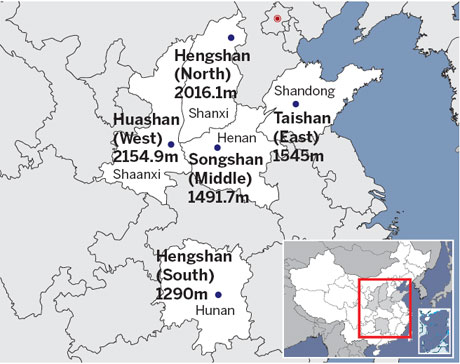Mountains to climb
Updated: 2011-09-09 08:34
By Yin Yin (China Daily)
|
Buddhist monks in action at the Shaolin Temple on Songshan Mountain. [Provided to China Daily] |
There are five magnificent natural wonders that have always commanded special respect
China is famous for its spectacular mountains, especially Qomolangma (Mount Everest). But there are another five mountains that enjoy a lofty reputation. Called the wuyue, they have been the key places of worship and cultural development for thousands of years.
Wuyue refers to the five directional mountains, which are located in the east, west, south, north and the middle of the country.
According to Chinese legend, wuyue originated from the limbs and head of the grand Pangu, the creator of the world.
"You don't want to see any mountain if you came back from the Five Great Mountains," an old saying goes.
1.Taishan Mountain (East)
Taishan Mountain is one of the birthplaces of Chinese civilization and from the Qin Dynasty (221-206 BC) to the Qing Dynasty (1644-1911), emperors came to the supreme peak to hold grand ceremonies and worship the gods of heaven and earth.
Located in Shandong province, it is regarded as the top-ranking of the wuyue and attracts millions of tourists each year.
Its main peak, Jade Emperor peak, is 1,545 meters above sea level, making it reasonably accessible for most travelers.
Watching the sunrise from the summit is a fine spectacle. The sun rises slowly up from the clouded horizon and the first bright beams of light shine on cypress pines. The trees cast fantastic shadows across the many curiously-shaped rocks.
In 1987 UNESCO added Taishan to its World Natural and Cultural Heritages list.
2.Huashan Mountain (West)
Huashan Mountain is known as the "No 1 mountain under Heaven" and is famous for its breathtaking views and steep paths. Its shape looks like a vast square column soaring to the sky.
Located in the south of Huayin county, this natural beauty is located 120 km east of Xi'an, in Shaanxi province, with an elevation of 2,200 m above sea level.
Huashan has been a hot spot for many influential Taoist temples, and has been a center for traditional Chinese martial arts.
The shape of West Peak is similar to a blooming lotus flower and is a popular place on the tourist route, however, hiking is challenging.
There is a section of the South Peak, where visitors must walk along a narrow plank, and hold on to a chain for dear life.
Huashan's hiking trails are among the most dangerous in the world. In fact, "hiking" is not the right word. "Climbing" is more apt.
Many who walk these paths are normal people, who take great risks without using climbing equipment or safety devices.
3.Hengshan Mountain (South)
Hengshan Mountain was a hunting area for emperors as well as a religious site where both Taoists and Buddhists coexisted.
The mountain is sometimes called Southern Heights Mountain (Nanyue Mountain) and is located in Hengyang city, Hunan province.
Among the 72 towering peaks of Hengshan Mountain, Zhurong Peak is the highest and rises 1,300 m above sea level.
At the foot of the mountain stands the biggest temple in southern China, the Grand Southern Heights Temple (Nanyue Damiao), which covers more than 98,500 sq m.
It was built during the Tang Dynasty (AD 618-907) and maintained through the Song Dynasty (960-1279) and reflects the artistic essence of each period. It has been destroyed by fire during various periods but was always rebuilt. The present temple dates from the Qing Dynasty and is based on Beijing's Imperial Palace.
4.Hengshan Mountain (North)
The name Hengshan is pronouced exactly the same as the previous top-five mountain but this natural wonder is 2,500 km away to the north in Hunyuan county of Shanxi province.
According to an ancient tale, Zhang Guolao, one of the Eight Taoist Immortals, lived here. Mao Ying, the founder of Maoshan Branch of Taoism also spent time here.
The mountain range spans 150 km, with the average elevation about 2,000 m.
At the foot of the mountain is the Hanging Temple and is known for its famous view. It was built during the Northern Wei Dynasty (AD 386-534) and over the years became a fusion of Buddhist, Taoist and Confucian schools of thought.
Climbing up to this site is not an easy job for those afraid of heights. The temple hangs 50 m above the ground and steep steps lead to up to its three main structures, which hang off the cliff face.
An interesting sideline is the Sweet and Bitter Wells that are positioned halfway up the mountain. The two wells are 1 m from each other, but their water quality is very different. One well's water is sweet, cool and refreshing, while the other is too bitter to drink.
Weather conditions can vary a great deal on Hengshan so be prepared.
5.Songshan Mountain (Middle)
The Shaolin Temple on Songshan Mountain is the most popular tourism attraction at this famous wuyue. It is considered the cradle of Chinese Buddhism's Zen philosophy and today monks continue to practice kungfu, meditation and learn Buddhist teachings.
The Shaolin Temple and its famous "Pagoda Forest" were listed as UNESCO heritage sites in 2010.
Songshan is located in Henan province near the city of Luoyang and is actually composed of two mountains - Taishi and Shaoshi.
The mountain is covered with lush forests that feature rare and ancient trees with literary quotations inscribed on them.
Also located on Songshan is the Songyang Academy, one of China's most famous oldest centers of learning. Great poets and philosophers gave lectures here.

E-paper

From death matches to child's play
You probably recognize the character (x) as a word of whimsy, but its origins are not so innocuous.
Tasting the new tapas
Mountains to climb
Short and sweet
Specials

China at her fingertips
Veteran US-China relations expert says bilateral ties have withstood the test of time

The myth buster
An outsider's look at china's leaders is updated and expanded

China in vogue
How Country captured the fascination of the world's most powerful fashion player

